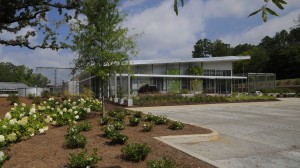
UM's new medicinal plant garden features parking lots surfaced with a pervious pavement to absorb rainwater and prevent erosion, green walls of climbing medicinal plants to shade its office/laboratory building and reduce energy costs, and a 20,000-gallon tank to collect rainwater running off its roofs.
OXFORD, Miss. – By design and its very nature and purpose, the new Maynard W. Quimby Medicinal Plant Garden complex at the University of Mississippi is the “greenest” facility on its Oxford campus.
Energy-efficient features of the complex’s new structures include natural lighting, a 20,000-gallon tank to collect rainwater running off the roofs and green “walls” of climbing medicinal plants to shade its laboratory building in summer. The complex also boasts construction that complies with Leadership in Energy and Environmental Design, commonly known as LEED, building practices.
“Even the garden’s parking lots are ‘green,'” said Donald Stanford, technical services manager in UM’s National Center for Natural Products Research. “They are paved with a pervious pavement that absorbs rainwater, rather than dispelling it, to prevent erosion.”The university is dedicating the new facilities April 17 in conjunction with its April 15-18 International Conference on the Science of Botanicals, which draws scientists from around the world to discuss medicinal plants and botanical dietary supplements. A reception and self-guided garden tour follow the dedication program.
“The Quimby Garden maintains a diverse, accurately identified and medicinally important living plant collection to support drug-discovery efforts within our School of Pharmacy and its National Center for Natural Products Research,” said Alice M. Clark, vice chancellor for research and sponsored programs. “But its value and impact extend far beyond our own research programs.”
The garden also is important to global conservation efforts and the U.S. Food and Drug Administration’s efforts to ensure the quality and safety of dietary supplements.
“By maintaining a living collection and a seed bank, we’re conserving valuable medicinal plant germ plasm (reproductive cells of an organism) ,” said Ikhlas Khan, NCNPR assistant director and director of its FDA Center for Excellence on Botanical Dietary Supplement Research. “There are many botanical gardens in the world, but only a few are dedicated to medicinal plant conservation.”
The Quimby Garden was moved to its new site on Insight Park Avenue to accommodate construction of the university’s new Insight Park on Hathorn Road. A new office and laboratory building, horticulture building, shade house, greenhouse and maintenance building were constructed on the garden’s new five-acre site, which also features areas for growing medicinal plants outdoors.
During construction, more than 270 mature trees were saved at the site to provide a canopy for a park-like area in which to grow shade-loving medicinal plants, and a small natural pond is available for growing aquatic medicinal plants.
“We’re extremely proud of our new location and facilities,” said NCNPR Director Larry Walker. “They are important to our drug-discovery efforts and provide educational opportunities to local residents and visitors, as well as FDA employees, who use the garden for one component of their training.”
As part of that training, FDA employees learn how to enforce Good Manufacturing Practices in the dietary supplement industry.
“We have trained more than 300 FDA inspectors to go out and monitor the dietary supplement industry, and we will train 150 more this year,” Khan said. “This work is important for the health and safety of U.S. consumers, because there are new companies, new products and new plants entering the industry at a rapid pace.”
The garden’s new administration and laboratory building contains a herbarium for storing voucher and reference samples of plant specimens, a seed bank with more than 1,500 entries and a taxonomy laboratory for plant identification and microscopy.
“This is where we maintain voucher specimens of the plants we grow, and a seed bank, so we have tissue for DNA extraction and can exchange seeds with collaborators,” Khan said.
A horticultural building provides controlled environments in which to process plant material in a manner that is compliant with Good Agricultural Practices. In this building, seeds are removed, cleaned and prepared for storage, and plants are dried, processed, bagged, labeled and stored until tested in NCNPR labs.
The Quimby Garden is registered with the Botanic Gardens Conservation International and is a member of the International Plant Exchange Network and the American Association of Botanical Gardens and Arboreta.
“Our garden maintains one of the nation’s largest collections of medicinal plants and provides material to researchers around the country and the world, in addition to our own,” said David D. Allen, UM pharmacy school dean. “Facilities like these, plus the incredible productivity of our teaching and research faculty, have helped to grow our national and international reputation for excellence in natural products research.”
A bronze bust of the late Maynard W. Quimby, one of the garden’s early developers, is displayed in the laboratory building’s lobby. Quimby, a former UM pharmacognosy professor, was president of the American Society of Pharmacognosy in the 1960s. His specialty was in the botany of Cannabis (aka marijuana or hemp) and other plants used for medicinal purposes around the world.
The garden’s new and greener facilities were designed by Cook, Douglas, Farr and Lemons of Jackson to comply with LEED building practices.